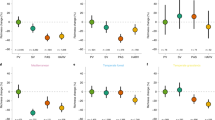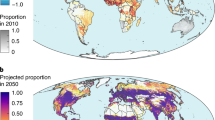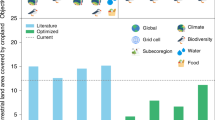Abstract
Agriculture is the leading driver of biodiversity loss. However, its future impact on biodiversity remains unclear, especially because agricultural intensification is often neglected, and high path-dependency is assumed when forecasting agricultural development—although the past suggests that shock events leading to considerable agricultural change occur frequently. Here, we investigate the possible impacts on biodiversity of pathways of expansion and intensification. Our pathways are not built to reach equivalent production targets, and therefore they should not be directly compared; they instead highlight areas at risk of high biodiversity loss across the entire option space of possible agricultural change. Based on an extensive database of biodiversity responses to agriculture, we find 30% of species richness and 31% of species abundances potentially lost because of agricultural expansion across the Amazon and Afrotropics. Only 21% of high-risk expansion areas in the Afrotropics overlap with protected areas (compared with 43% of the Neotropics). Areas at risk of biodiversity loss from intensification are found in India, Eastern Europe and the Afromontane region (7% species richness, 13% abundance loss). Many high-risk regions are not adequately covered by conservation prioritization schemes, and have low national conservation spending and high agricultural growth. Considering rising agricultural demand, we highlight areas where timely land-use planning may proactively mitigate biodiversity loss.
This is a preview of subscription content, access via your institution
Access options
Access Nature and 54 other Nature Portfolio journals
Get Nature+, our best-value online-access subscription
$29.99 / 30 days
cancel any time
Subscribe to this journal
Receive 12 digital issues and online access to articles
$119.00 per year
only $9.92 per issue
Buy this article
- Purchase on Springer Link
- Instant access to full article PDF
Prices may be subject to local taxes which are calculated during checkout



Similar content being viewed by others
References
Ramankutty, N., Evan, A. T., Monfreda, C. & Foley, J. A. Farming the planet: 1. Geographic distribution of global agricultural lands in the year 2000. Global Biogeochem. Cycles 22, GB1003 (2008).
Maxwell, S., Fuller, R., Brooks, T. & Watson, J. The ravages of guns, nets and bulldozers. Nature 536, 143 (2016).
Sala, O. E. et al. Global biodiversity scenarios for the year 2100. Science 287, 1770–1774 (2000).
Tilman, D., Balzer, C., Hill, J. & Befort, B. L. Global food demand and the sustainable intensification of agriculture. Proc. Natl Acad. Sci. USA 108, 20260–20264 (2011).
Titeux, N. et al. Biodiversity scenarios neglect future land-use changes. Glob. Change Biol. 22, 2505–2515 (2016).
Pereira, H. M. et al. Scenarios for global biodiversity in the 21st century. Science 330, 1496–1501 (2010).
Shackelford, G. E., Steward, P. R., German, R. N., Sait, S. M. & Benton, T. G. Conservation planning in agricultural landscapes: hotspots of conflict between agriculture and nature. Diversity Distrib. 21, 357–367 (2015).
Phalan, B., Green, R. & Balmford, A. Closing yield gaps: perils and possibilities for biodiversity conservation. Phil. Trans. R. Soc. B Biol. Sci. 369, 20120285 (2014).
Rondinini, C. & Visconti, P. Scenarios of large mammal loss in Europe for the 21st century. Conserv. Biol. 29, 1028–1036 (2015).
Visconti, P. et al. Projecting global biodiversity indicators under future development scenarios. Conserv. Lett. 9, 5–13 (2015).
Bellard, C. et al. Vulnerability of biodiversity hotspots to global change. Glob. Ecol. Biogeogr. 23, 1376–1386 (2014).
de Baan, L., Alkemade, R. & Koellner, T. Land use impacts on biodiversity in LCA: a global approach. Int. J. Life Cycle Assessment 18, 1216–1230 (2013).
Visconti, P. et al. Future hotspots of terrestrial mammal loss. Phil. Trans. R. Soc. B Biol. Sci. 366, 2693–2702 (2011).
Kehoe, L. et al. Global patterns of agricultural land-use intensity and vertebrate diversity. Diversity Distrib. 21, 1308–1318 (2015).
Foley, J. A. et al. Solutions for a cultivated planet. Nature 478, 337–342 (2011).
Clough, Y. et al. Combining high biodiversity with high yields in tropical agroforests. Proc. Natl Acad. Sci. USA 108, 8311–8316 (2011).
Tscharntke, T. et al. Global food security, biodiversity conservation and the future of agricultural intensification. Biol. Conserv. 151, 53–59 (2012).
Alkemade, R. et al. GLOBIO3: a framework to investigate options for reducing global terrestrial biodiversity loss. Ecosystems 12, 374–390 (2010).
Müller, C. & Lotze-Campen, H. Integrating the complexity of global change pressures on land and water. Glob. Food Secur. 1, 88–93 (2012).
Rosen, R. A. IAMs and peer review. Nat. Clim. Change 5, 390–390 (2015).
Ramankutty, N. & Coomes, O. T. Land-use regime shifts: an analytical framework and agenda for future land-use research. Ecol. Soc. 21, 1 (2016).
Jepsen, M. R. et al. Transitions in European land-management regimes between 1800 and 2010. Land Use Policy 49, 53–64 (2015).
Müller, D. et al. Regime shifts limit the predictability of land-system change. Glob. Environ. Change 28, 75–83 (2014).
Nadeau, C. P., Urban, M. C. & Bridle, J. R. Coarse climate change projections for species living in a fine-scaled world. Glob. Change Biol. 23, 12–24 (2016).
Erb, K.-H. et al. Exploring the biophysical option space for feeding the world without deforestation. Nat. Commun. 7, 11382 (2016).
Hudson, L. N. et al. The PREDICTS database: a global database of how local terrestrial biodiversity responds to human impacts. Ecol. Evol. 4, 4701–4735 (2014).
Newbold, T. et al. Global effects of land use on local terrestrial biodiversity. Nature 520, 45–50 (2015).
Hurlbert, A. H. & Jetz, W. Species richness, hotspots, and the scale dependence of range maps in ecology and conservation. Proc. Natl Acad. Sci. USA 104, 13384–13389 (2007).
The World Database on Protected Areas (WDPA) (UNEP-WCMC, Cambridge, 2016).
World Bank Group World Development Indicators (World Bank Publications, 2013).
Waldron, A. et al. Targeting global conservation funding to limit immediate biodiversity declines. Proc. Natl Acad. Sci. USA 110, 12144–12148 (2013).
Green, R. E., Cornell, S. J., Scharlemann, J. P. W. & Balmford, A. Farming and the fate of wild nature. Science 307, 550–555 (2005).
Donald, P. F., Pisano, G., Rayment, M. D. & Pain, D. J. The Common Agricultural Policy, EU enlargement and the conservation of Europe’s farmland birds. Agric. Ecosyst. Environ. 89, 167–182 (2002).
Hartel, T., Schweiger, O., Ollerer, K., Cogalniceanu, D. & Arntzen, J. W. Amphibian distribution in a traditionally managed rural landscape of Eastern Europe: probing the effect of landscape composition. Biol. Conserv. 143, 1118–1124 (2010).
Mittermeier, R. A. et al. Hotspots Revisited: Earth's Biologically Richest and Most Endangered Terrestrial Ecoregions (CEMEX, Mexico City, 2004).
Brooks, T. M. et al. Global biodiversity conservation priorities. Science 313, 58–61 (2006).
Cook, C. N., Wintle, B. C., Aldrich, S. C. & Wintle, B. A. Using strategic foresight to assess conservation opportunity. Conserv. Biol. 28, 1474–1483 (2014).
Oliver, T. H. & Roy, D. B. The pitfalls of ecological forecasting. Biol. J. Linnean Soc. 115, 767–778 (2015).
Searchinger, T. D. et al. High carbon and biodiversity costs from converting Africa’s wet savannahs to cropland. Nat. Clim. Change 5, 481–486 (2015).
Estes, L. D. et al. Reconciling agriculture, carbon and biodiversity in a savannah transformation frontier. Phil. Trans. R. Soc. Lond. B Biol. Sci. 371, 20150316 (2016).
Wilcove, D. S., Giam, X., Edwards, D. P., Fisher, B. & Koh, L. P. Navjot’s nightmare revisited: logging, agriculture, and biodiversity in Southeast Asia. Trends Ecol. Evol. 28, 531–540 (2013).
Laurance, W. F. et al. The fate of Amazonian forest fragments: a 32-year investigation. Biol. Conserv. 144, 56–67 (2011).
Fischer, J. et al. Land sparing versus land sharing: moving forward. Conserv. Lett. 7, 1755–2630 (2014).
Scheffer, M. et al. Anticipating critical transitions. Science 338, 344–348 (2012).
Lee, T. M. & Jetz, W. Future battlegrounds for conservation under global change. Proc. R. Soc. B Biol. Sci. 275, 1261–1270 (2008).
Tingley, M. W., Estes, L. D. & Wilcove, D. S. Ecosystems: Climate change must not blow conservation off course. Nature 500, 271–272 (2013).
Estes, L. D. et al. Using changes in agricultural utility to quantify future climate-induced risk to conservation. Conserv. Biol. 28, 427–437 (2014).
van Asselen, S. & Verburg, P. H. A land system representation for global assessments and land-use modeling. Glob. Change Biol. 18, 3125–3148 (2012).
Fritz, S. et al. Mapping global cropland and field size. Glob. Change Biol. 21, 1980–1992 (2015).
Hansen, M. C. et al. High-resolution global maps of 21st-century forest cover change. Science 342, 850–853 (2013).
ESA-CCI. CCI Land Cover Project http://www.esa-landcover-cci.org/?q=node/158 (ESA, 2016).
Wint, W. & Robinson, T. Gridded Livestock of the World (FAO: Rome, 2007).
Global Agro-ecological Zones (GAEZ v3.0) http://www.fao.org/nr/gaez/en/ (IIASA/FAO, 2012).
Verburg, P., Neumann, K. & Nol, L. Challenges in using land use and land cover data for global change studies. Glob. Change Biol. 17, 974–989 (2011).
Fritz, S. et al. Highlighting continued uncertainty in global land cover maps for the user community. Environ. Res. Lett. 6, 044005 (2011).
Mascia, M. B. & Pailler, S. Protected area downgrading, downsizing, and degazettement (PADDD) and its conservation implications. Conserv. Lett. 4, 9–20 (2011).
Gibbs, H. K. et al. Tropical forests were the primary sources of new agricultural land in the 1980s and 1990s. Proc. Natl Acad. Sci. USA 107, 16732–16737 (2010).
Mueller, N. D. et al. Closing yield gaps through nutrient and water management. Nature 490, 254–257 (2012).
Pradhan, P., Fischer, G., van Velthuizen, H., Reusser, D. E. & Kropp, J. P. Closing yield gaps: how sustainable can we be? PLoS ONE 10, e0129487 (2015).
Nepstad, D. C. & Stickler, C. M. Managing the tropical agriculture revolution. J. Sustainable For. 27, 43–56 (2008).
Angelsen, A. & Kaimowitz, D. in Agricultural Technologies and Tropical Deforestation (eds. Angelsen, A. & Kaimowitz, D.) 1–18 (CABI, Wallingford, 2001).
Hertel, T. W., Ramankutty, N. & Baldos, U. L. C. Global market integration increases likelihood that a future African Green Revolution could increase crop land use and CO2 emissions. Proc. Natl Acad. Sci. USA 111, 13799–13804 (2014).
Delgado, C., Rosegrant, M., Steinfeld, H., Ehui, S. & Courbois, C. Livestock to 2020: the next food revolution. Outlook Agric. 30, 27–29 (2001).
Naylor, R. et al. Losing the links between livestock and land. Science 310, 1621–1622 (2005).
Bird Species Distribution Maps of the World (BirdLife International, Cambridge, and NatureServe, Arlington, 2015).
IUCN Red List of Threatened Species Version 2016-1 http://www.iucnredlist.org (IUCN; accessed 2 February 2016).
Kuussaari, M. et al. Extinction debt: a challenge for biodiversity conservation. Trends Ecol. Evol. 24, 564–571 (2009).
Living Planet Report 2012 (World Wildlife Fund, Gland, 2012).
Kuemmerle, T. et al. Challenges and opportunities in mapping land use intensity globally. Curr. Opin. Environ. Sustainability 5, 484–493 (2013).
Loos, J. et al. Putting meaning back into ‘sustainable intensification’. Front. Ecol. Environ. 12, 356–361 (2014).
Grenyer, R. et al. Global distribution and conservation of rare and threatened vertebrates. Nature 444, 93–96 (2006).
Olson, D. M. & Dinerstein, E. The Global 200: priority ecoregions for global conservation. Ann. Missouri Bot. Gard. 89, 199–224 (2002).
Sanderson, E. W. et al. The human footprint and the last of the wild. Bioscience 52, 891–904 (2002).
A Global Standard for the Identification of Key Biodiversity Areas Version 1.0, 1st edn (IUCN, Gland, 2016).
Spotlight on Important Bird and Biodiversity Areas http://www.birdlife.org/datazone (BirdLife International, 2014).
Acknowledgements
We thank T. Newbold for comments and insights on an earlier version of the manuscript, and P. Verburg, D. Eitelberg and D. Müller for constructive discussions. We thank F. Pötzschner and B. Jakimow for technical support. L.K. and T.K. acknowledge funding by the Einstein Foundation Berlin (Germany).
Author information
Authors and Affiliations
Contributions
L.K. and T.K. conceived the study. L.K. collected and analysed the data, and prepared the manuscript. A.R.M. and E.P. assisted in analysing the data. All authors discussed the results and commented on the manuscript.
Corresponding author
Ethics declarations
Competing interests
The authors declare no competing financial interests.
Additional information
Publisher’s note: Springer Nature remains neutral with regard to jurisdictional claims in published maps and institutional affiliations.
Electronic supplementary material
Supplementary Information
Supplementary Figures 1–4, Supplementary Table 1, Supplementary References
Supplementary Information Tables 2-7
Supplementary Tables 2–7
Rights and permissions
About this article
Cite this article
Kehoe, L., Romero-Muñoz, A., Polaina, E. et al. Biodiversity at risk under future cropland expansion and intensification. Nat Ecol Evol 1, 1129–1135 (2017). https://doi.org/10.1038/s41559-017-0234-3
Received:
Accepted:
Published:
Issue Date:
DOI: https://doi.org/10.1038/s41559-017-0234-3
This article is cited by
-
Telecoupled impacts of the Russia–Ukraine war on global cropland expansion and biodiversity
Nature Sustainability (2024)
-
Spatiotemporal variations of non-farming use of cropland in China under different SSP-RCP scenarios
Regional Environmental Change (2024)
-
Carbonservation with Demonstrated Biodiversity and Carbon Gains: Carbon Can Pay But Biodiversity Must Lead
Environmental Management (2024)
-
Meta-analysis unveils differential effects of agroforestry on soil properties in different zonobiomes
Plant and Soil (2024)
-
Ecological filtering shapes the impacts of agricultural deforestation on biodiversity
Nature Ecology & Evolution (2024)



